In 1996 a summary Barcaldine Cemetery Register was compiled by/for Barcaldine Shire Council. I have been able to do an analysis from the data contained in it – although there does appear to be some small typos/errors in it.
The following graphics represent the results for number, sex, age and burial section from 1889-1996.
Number of Burials overall - by decade
The Register shows that the first burial in the new cemetery occurred on 4 May 1889 – Interment No. 0001 – for an Ah Foo.
There were 302 interments in the first decade of burials in the new cemetery. The number of burials gradually decreased in the second decade (1900 to1909).
The downward trend in the number of burials overall was short lived, however, as the rate climbed for the next two decades (1909 to 1929) until it spiked in 1929 at 330.
It then continued to trend down to 1996.

It was not uncommon for more than one burial to occur on one day, or on consecutive days. The worst days were the bushfire deaths in 1918. In one week seven stockmen were buried after dying from their burns.
Graves often held more than one body. Some of the early grave sites held up to seven bodies - added over time and apparently not always members of the same family. Bodies of more than one child were not uncommon in some graves.
Not all recorded burials listed the sex and/or age of the deceased, so the totals for the data I have analysed are likely to be higher.
For example, the age of babies was not always recorded. Sometimes their names were not recorded – possibly because they were premature or stillborn so the parents did not provide a name.
We need to remember that families in the early days were usually large, with 11 children not uncommon, and also that many children did not survive childhood.
AGE
So many babies - almost half of all burials
The number of burials for babies under one year of age made up almost half of all burials in the first decade.

The number of infants buried in the early days is a sobering reminder of how difficult life was then. The Victoria Hospital did not open until March 1888, and the medical staff were not always well trained or competent. Some of the doctors drank too much.
Midwives advertised in the local newspaper – the Western Champion – so babies were usually delivered out of the hospital in local private homes or maternity homes.
Both mothers and babies died during childbirth at an alarming rate by today’s statistics – a ‘normal’ occurrence at the time and not by any means confined to Barcaldine.
The burial rate for infants did gradually decrease from a high of 145 in the first decade to a low of 2 in the 1990s.
The babies and infants died at various points in their first year – stillborn, mere hours old, days, weeks, months.
Some were twins, some were premature. Others would have succumbed to childhood diseases and accidents.
The longer they lived after birth, the better their chances.
Stillborn births and those babies who lived for only hours took longer to decline in number.

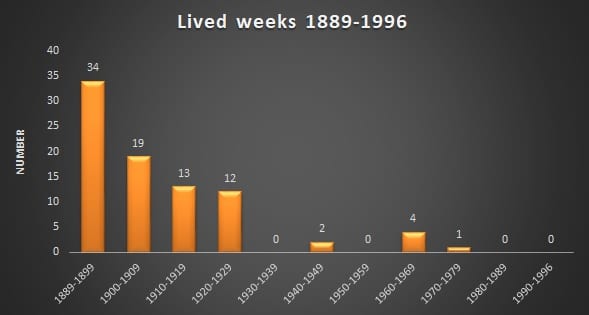

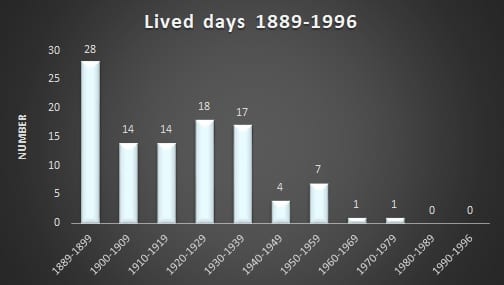
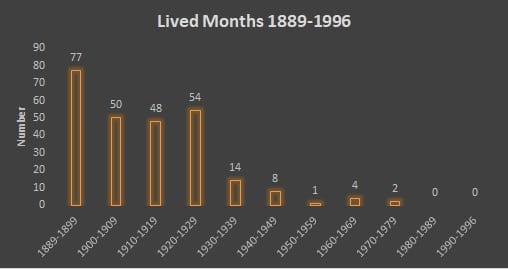
Children and young adults under the age of 21 years
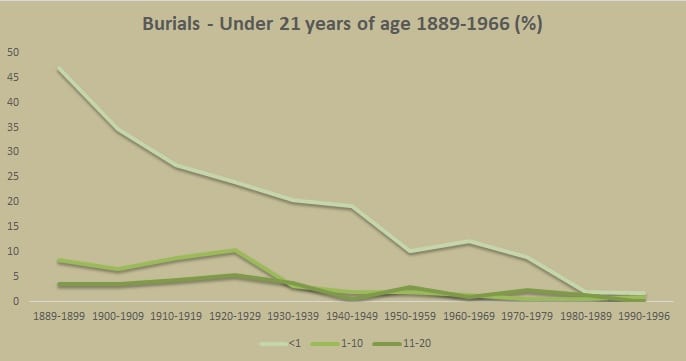
Burials for infants and young people under the age of 21 gradually decreased over the years from 1889 to 1996. As the graphic shows, the rate of burial was much lower if children made it to their first birthday.
It wasn’t until the 1980s however that the number of burials for children under 1 year old levelled out with those aged between 1 and 20 years of age.
Over 50s
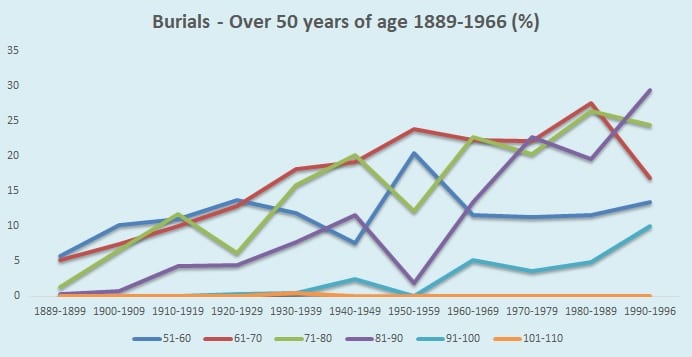
At the other end of the burial spectrum, older people lived longer as the decades passed. People did not live as long in the early days, so the graphic for those over 50 years of age shows an inverse relationship to that for theunder 21 year olds.
Of course, along with the rest of the western world, the age at which people died gradually rose as medical treatment and the hospital services improved.
The oldest person to be buried in the Barcaldine cemetery – up until 1996 – was 102 years old (Luoi Quay in 1930)
SEX
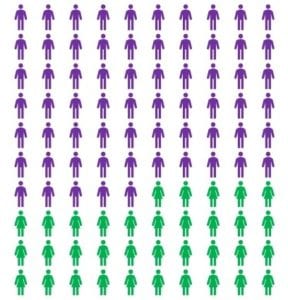
From 1889-1996 men made up just over two thirds (66%) of burials in the new cemetery.
You were more likely to die if you were male in the early days.
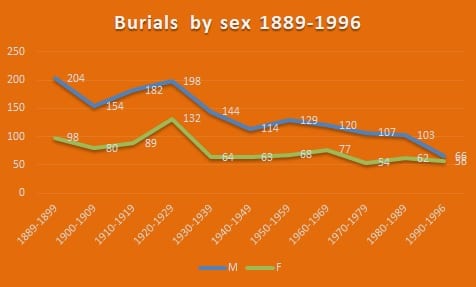
In the decade from 1889-1899, 204 men were buried and 98 women.
The gap between the sexes didn’t narrow consistently until the 1980s.
By 1996, the gap was down to 10.
The number of men buried was higher in the earlier decades probably because: there were more men living in the area than women, they were employed in dangerous occupations including working with livestock, men were more likely to be killed in accidents or whilst engaged in risky behaviour, men were more likely to die by suicide judging by the reports in the local newspaper.
SECTION
Catholic, Protestant, RSL, Non-denominational
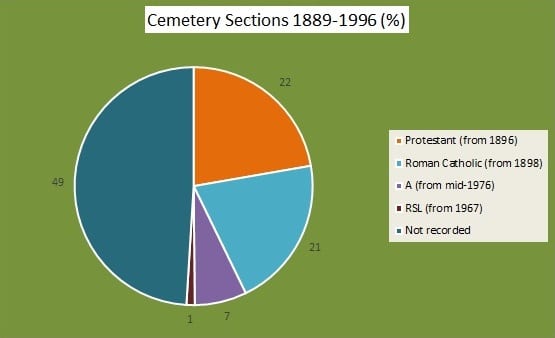
For the first eight years all burials were recorded without religious affiliation.
In 1897 (8 years after the new cemetery began operation), Council gave approval for Roman Catholics to be buried in their own section.
The largest number of burials recorded in the Register until 1996 were those without any religious association (49%).
ROMAN CATHOLIC SECTION (21%)
A Roman Catholic section was included on the original plan for the new cemetery but the first Roman Catholic burial was not registered until 1898.
Roman Catholic burials were still being recorded in the Register in 1996.
PROTESTANT SECTION (22%)
The first person buried and recorded as a Protestant occurred in 1896 (my grandmother Hannah Rodgers).
By 1996, new sections had been added to the cemetery site.
SECTION A (7%)
The first burial in Section A was registered in mid-1976. This section would have grown markedly since then as all new burials are now in Section A.
RSL SECTION (1%)
An RSL section was added and the first burial registered in 1967.
Other sections?
I have seen reference to the existence of a pauper section where those unfortunates without financial means to pay for a a funeral or burial plot were interred. Their plots were apparently without any identification markings. I haven’t been able to verify where the pauper section may be situated on the plan. It may well be that paupers were buried in plots in the general cemetery but without ID markers.
I have also heard that it was common practice in other cemeteries for those who died by suicide to be permitted to only be buried in unmarked graves. I have no evidence that this happened in the Barcaldine cemetery but it may have been the case if it was common elsewhere.
